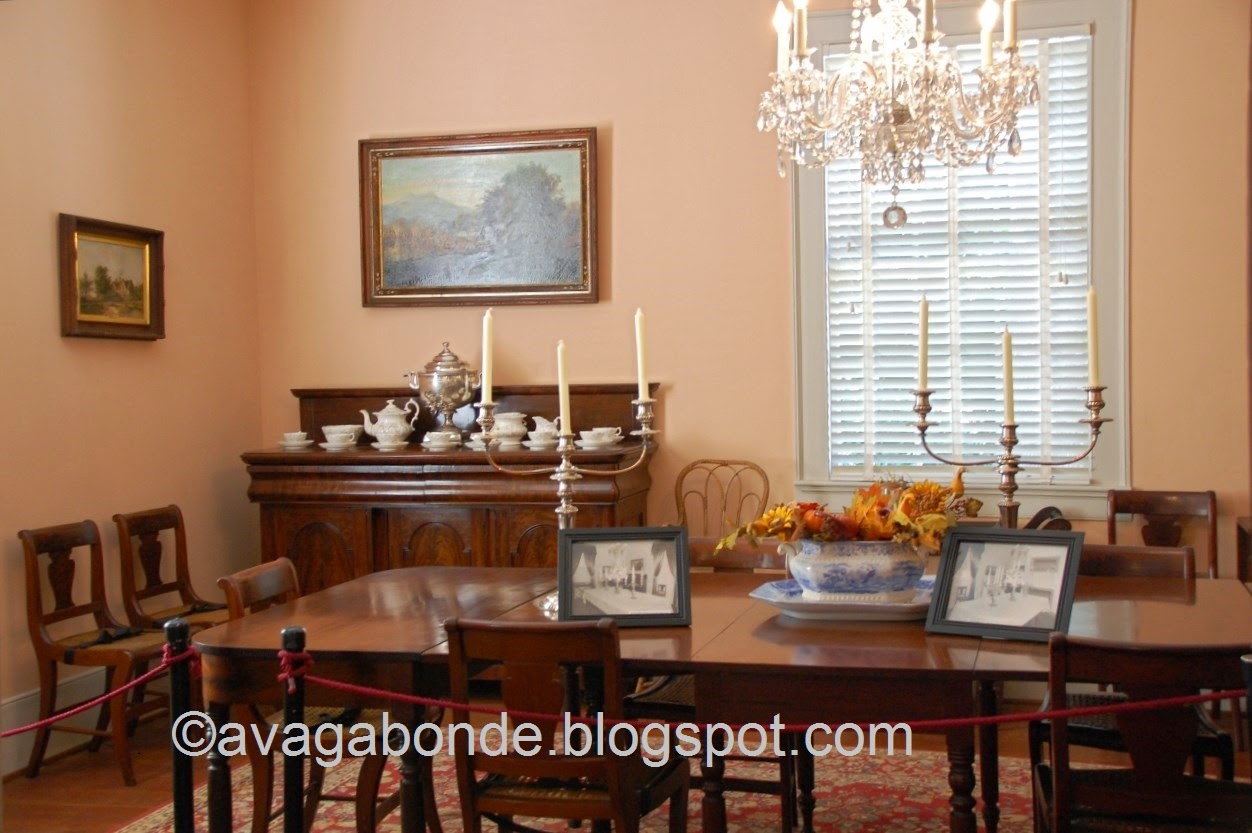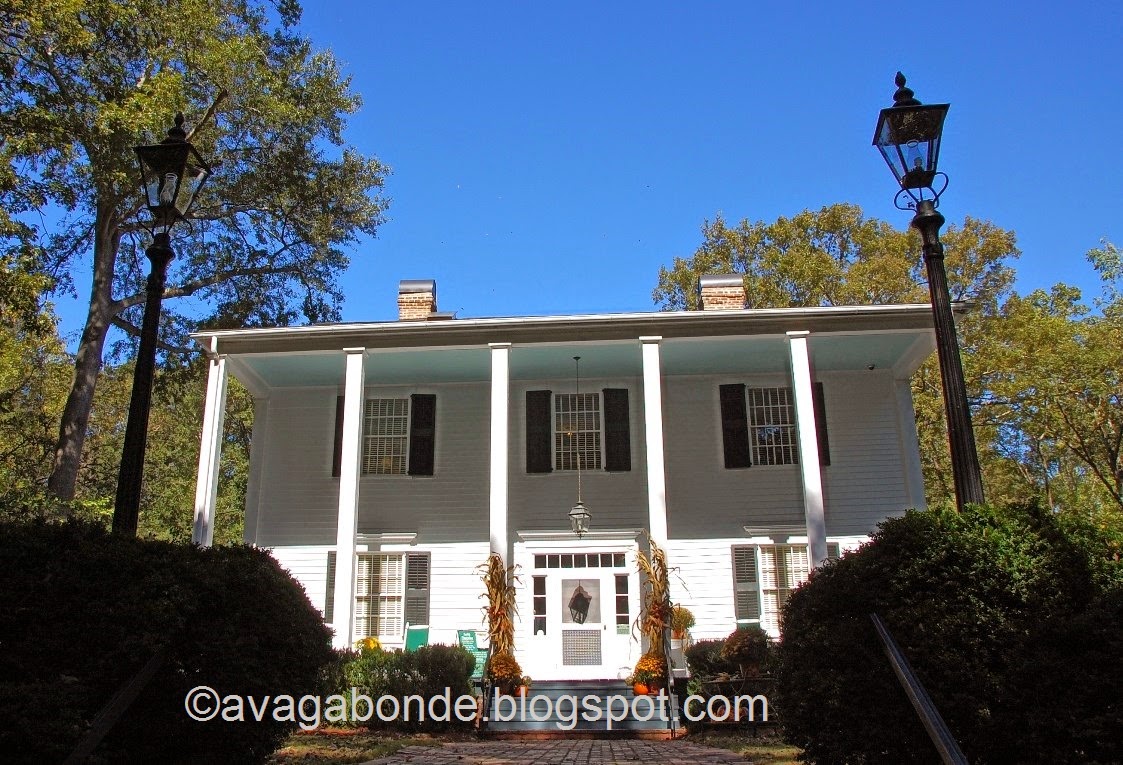Since visiting this plantation I have read up on its history. Archibald Smith was born in Savannah, Georgia, in 1801, and had married his cousin, Anne Magill, in 1830. They had two plantations along the coast near St. Mary, Georgia, (below Savannah,) which were struggling financially. The Smiths were strict and devout Presbyterians. Another Presbyterian, Roswell King, was founding a small town in North Georgia, named after him, and invited the Smiths to come up and settle there. Archibald Smith moved to Roswell with his wife, their four children and 30 of their slaves in 1838. Archibald was the only farmer among the founding fathers - the others were involved in the cotton mill. The Smith farmhouse and outbuildings were built, between 1843-1845, a mile from the Roswell town square. The Smith plantation included 300 acres (1.2 km2) of cotton-producing land. Below is a picture of Archibald and his wife Anne.
Three generations have lived in this house and saved many family belongings which are on display. Arthur William Smith (1881-1960) the grandson of Archibald married Mary Norvell in 1940 and they renovated the historic home. Arthur had studied architecture at the Ecole des Beaux Arts in Paris and his wife had a Master of Arts degree from Columbia University. The house was in the Plantation Plain-style and had been left unoccupied for 25 years. Below is how the house looked before and after renovation. (Courtesy Georgia Archives.)
Apart from these renovations the house has been left pretty much the same during these past 169 years. As we entered the house, we went back in time. A docent took us to look at several family photographs and explained the family tree. Archibald and his wife Anne raised two daughters (who stayed single) and two sons in this plantation home. Both sons fought in the Confederate Army. Archibald, Jr., "Archie" (1844-1923) was the only child to marry. Archie's son, Arthur William Smith, was the last Smith descendant who married Mary Norvell when he was almost 60 years old. They had no children and when Mary died on New Year's Day 1981 the house passed to her niece, Josephine Skinner. Below are the family pictures with enlargements of Archie, Mary and William Smith. (Click on collage to enlarge.)
We passed from the hall to the office library. It has original family furnishing from the first to the last generation, such as Archibald's desk to an old television console and small portable record player.
The parlor also contains fine antiques. When the Smiths fled Roswell during the Civil War they moved their 1833 piano to the Georgia-Florida frontier - to Valdosta, Georgia.
A black trunk can be seen in the picture above - this is William Smith's (1834-1865) trunk. "Willie" as he was called - the other son of Archibald Smith - was stationed near Savannah during the Civil War. As General Sherman of the Union Army was taking control of the Savannah area, Willie sent his trunk with his belongings back to the family. Unfortunately Willie died during the long march home, two weeks after the Civil War ended. The family was devastated. The trunk was put away in the attic. (Pictures below courtesy Roswell Historic and Cultural Affairs.)
There Willie's trunk stood, undisturbed, until Arthur Skinner, one of the heirs of the estate, found it in 1987 - 122 years later. The trunk contained letters, clothing and more. Arthur and his brother, Dr. J. Lister Skinner, selected some of the letters and published them in a book "The Death of a Confederate" (which I found second-hand and have ordered.) Willie had written a list of the items contained in his trunk, and most of them were still there. Below is the trunk which contained Willie's coat as well as a little box of quinine pills among other personal items. The trunk was donated to the Smith Plantation in 2006.
A lovely seasonal arrangement was centered on the banquet-size walnut table in the dining room. The table is original to the house.
There was also an Empire style crotch mahogany sideboard from the 1860s.
We went upstairs to view the bedrooms. Some clothing from the 19th century was displayed as well as a "washing tub."
The last resident of the house was the housekeeper Mamie Cotton. She started working as a cook for the Smith household in 1940 and was in their employ for 54 years. When Arthur Smith died in 1960, Mamie Cotton moved into the house to take care of Mary Norvell Smith until Mary's death in 1981. When the Smith property was sold to the city of Roswell one of the stipulations of the sale was that Mamie Cotton be allowed to live the rest of her life in the house. Mamie passed away in 1994. Here is her picture below, courtesy Roswell Historic and Cultural Affairs.
Below is the kitchen now.
On the back porch is a door going to a small room that was called a "Traveler's or Parson's Room." It used to be left unlocked so that any passing traveler or preacher who needed a room for the night could stay there. In the morning he would have had breakfast with the family and provided them with any news he was aware of. Below you can see the wall of that room on the right, next to the window.
As you can see it was a warm and bright day - not much fall color showing and a temperature of 80 degree F (26.5 C) in the shade. In 1980 the Skinner family sold 32 acres of the plantation land to the city of Roswell for a municipal complex. Then in 1984 they sold the plantation home and 10 original outbuildings on the 8 acre-grounds for $125,000 to the city of Roswell also. This was a much lower price than had been offered by developers to the Skinners, but they wished to have the property preserved. The house has been opened to the public since 1992 (while Mamie Cotton still lived there.) We walked around the house to the cookhouse, which was used as a kitchen for the plantation until 1915. Now it is used for cooking demonstrations.
Then we walked by the caretaker's house. Originally built in 1844 it was destroyed in 1996 when a huge tree fell on it. A sign indicates that this was the second oldest white oak tree in the State of Georgia (250 to 300 years old.) Below is a picture showing the tree, when standing and when it fell (courtesy Jim Skinner.) The house is now an office.
The carriage house built in the 1850s was converted into a garage in the 1940s.
The slave cabins were torn down a long time ago but there is a slave dwelling representative of such a building. Being close to the house this would have been used by house servants. There is an old picture of a slave cabin, but the type that would have been for slaves in the fields.
Walking around the house and in the gardens, I was surprised to see so many tall lamp posts. I found out that Mary Norvell Smith purchased approximately 39 London street lights from the City of London in 1960. They were shipped on the Queen Mary. They were electrified and placed on the Smith Plantation grounds. Here is one below in front of the house.
Below is another London lamp post on the grounds.
Here is an interesting fact that I discovered: on the information panel in the slave cabin (shown above) I read that Archibald Smith's farm in St. Mary in coastal Georgia had been named "Appenzelle" which I thought an unusual name for a southern farm and believed it was for a reason. I knew of Appenzell, a city and canton in Switzerland. So I did some digging and found out that around 1730 or so the new colony of Georgia, had sent PR leaflets to Europe to entice immigrants to settle in this new southern frontier. In 1737 two hundred Swiss immigrants from Canton Appenzell relocated close to Augusta, Georgia, near the Savannah River, in Beech Island. The leader of these German and French speaking Swiss settlers was John Tobler. Anna Tobler (1725-1765) came to Georgia from Appenzell and was the great-grand mother of both Archibald Smith and his wife Anne Magill Smith (they were cousins.) So this is why Archibald Smith had called his plantation Appenzelle. Below are photos of Appenzell (courtesy French General Consulate in Zurich) and two vintage postcards showing Appenzell costumes.
The Archibald Smith Plantation is a beautiful place but, it does not have the mountain vistas of Canton Appenzell. I played with my photos and made the house in sepia color.
Then I used the "paint" option and made my photo of the house as a watercolor. But in black and white, sepia, or in color, it is truly a lovely place to visit. With the house museum, all the artifacts, buildings and structures we got a glimpse at the lives of the inhabitants of this "big house" in the antebellum Deep South.









































































